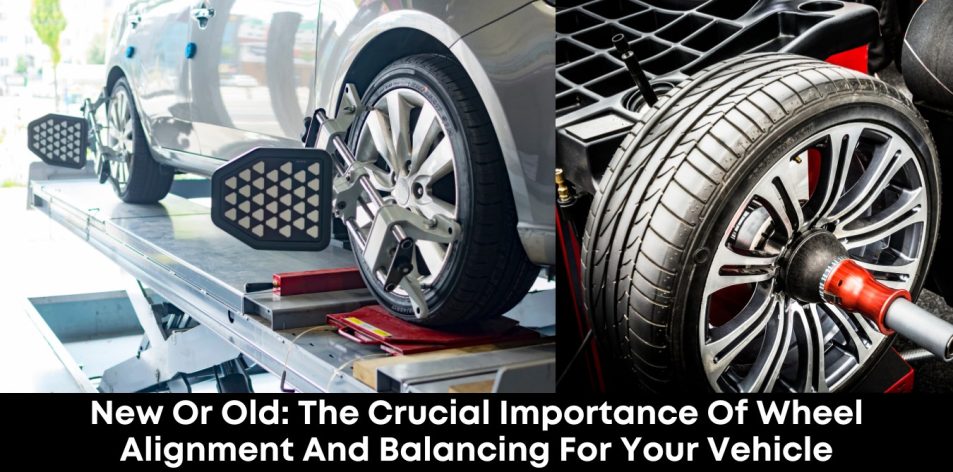Ensuring a Smooth, Safe, and Cost-Effective Drive
Whether you’ve just driven a brand-new car out of the showroom or purchased a pre-owned vehicle, the excitement of a new ride is undeniable. However, an essential step that is often overlooked in the early days of ownership is having the wheels aligned and balanced. These two maintenance procedures, while often confused with one another, are critical for a vehicle’s performance, safety, and longevity. This article breaks down what wheel alignment and balancing are, their distinct benefits, and why they should be a priority for any vehicle owner, new or old.
Wheel Alignment vs. Wheel Balancing: What’s the Difference?
Think of it this way: Wheel alignment is about adjusting the angles of your vehicle’s suspension system so that the wheels sit correctly and make proper contact with the road. It ensures that all four wheels are parallel to each other and perpendicular to the ground. This process doesn’t involve the wheels or tyres themselves, but rather the suspension components that hold them in place. The main goal is to ensure your vehicle travels in a straight line without pulling to one side.
Wheel balancing, on the other hand, is about the wheel and tyre assembly itself. It’s a procedure that corrects for any uneven distribution of weight around the wheel’s circumference. Even a slight imbalance of a few grams can cause vibrations as the wheel spins at high speeds. During balancing, a technician uses a special machine to identify these light spots and adds small weights to the rim to create a perfectly balanced and smooth-spinning assembly.
The Undeniable Importance for Every Vehicle
For both new and used cars, alignment and balancing are not optional—they are fundamental for a multitude of reasons:
1. For a New Car
You might assume a new car comes perfectly calibrated, and while it should, the journey from the factory to the dealership and then to your home can involve bumps and minor impacts that can throw things slightly out of sync. A pothole, a curb, or even the process of shipping can affect the delicate settings.
- Ensures Factory-Level Performance: A quick check of alignment and balancing confirms that your vehicle is performing exactly as the manufacturer intended, providing the smoothest and safest ride possible.
- Peace of Mind: Starting your ownership journey with a perfectly tuned vehicle gives you confidence that you’re on the right track with maintenance from day one.
2. For a Used Car
The previous owner’s driving habits, road conditions, and maintenance history are unknown variables. A used car is far more likely to have wheels that are out of alignment or balance due to natural wear and tear or past impacts.
- Identifies and Fixes Hidden Problems: A professional inspection can reveal issues that might not be immediately obvious, such as uneven tyre wear, which could indicate a deeper problem with the suspension.
- Prevents Future Damage: Correcting these issues early on prevents them from causing more severe and costly damage to tyres, suspension components, and the steering system.
The Core Benefits You’ll Experience
Improved Safety
Properly aligned and balanced wheels mean your car handles predictably and responds correctly to steering inputs. Your car won’t pull to one side, which is especially important during sudden braking or on winding roads, significantly reducing the risk of an accident.
Extended Tyre Lifespan
Misaligned wheels or an imbalanced wheel assembly cause tyres to wear down unevenly and prematurely. This leads to costly replacements far sooner than necessary. Regular alignment and balancing ensure that your tyres wear evenly, maximising their lifespan and saving you money.
Better Fuel Efficiency
When wheels are misaligned, they drag against the road, forcing your engine to work harder to maintain speed. This increased rolling resistance results in a noticeable drop in fuel economy. By having your wheels aligned, you ensure your car is as efficient as possible, which is a major financial benefit.
A Smoother, More Comfortable Ride
Imbalanced wheels cause vibrations that you can feel through the steering wheel, floor, or seats, especially at higher speeds. These vibrations can be annoying and tiring for the driver and passengers. Proper balancing eliminates these vibrations, providing a quiet and comfortable driving experience.
Reduced Wear on Vehicle Components
Beyond the tyres, a misaligned or unbalanced wheel system puts extra strain on your vehicle’s suspension, steering, and bearing components. Over time, this can lead to premature wear and tear, and potentially expensive repairs. Regular maintenance of your wheels protects these vital parts of your car.
When Should You Have It Done?
For a newly acquired car, it’s a smart idea to get both an alignment and balancing check shortly after purchase. Following this, it’s generally recommended to have your alignment checked every 10,000 to 15,000 kilometres or after any significant impact, such as hitting a large pothole or curb. Balancing should be done every time you replace or rotate your tyres, or whenever you notice vibrations in the steering wheel or car body.
In conclusion, wheel alignment and balancing are non-negotiable aspects of vehicle ownership. They are small investments that provide huge returns in safety, performance, and long-term savings. By prioritising this crucial maintenance, you ensure that your vehicle remains a reliable, efficient, and secure asset on the road.

